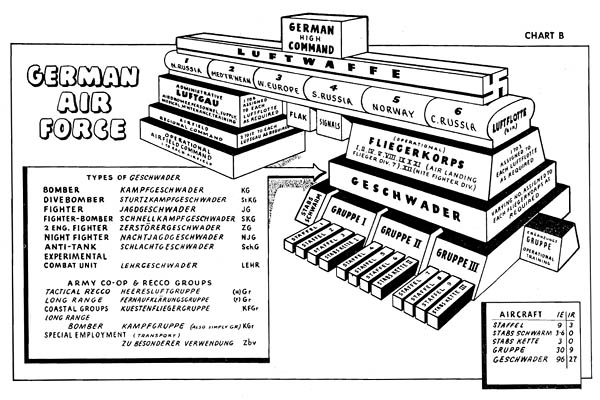Organization of the WWII German Luftwaffe from the U.S. War Department’s Handbook for Combat Air Intelligence Officers, Army Air Forces Air Intelligence School, Harrisburg, Pennsylvania, March 1944.
2. ORGANIZATION.
a. General.
(1) The German Air Force (Luftwaffe) is one of three branches of the German Armed Forces (Wehrmacht) and is organized and administered independently of the Army and the Navy.
(2) The Luftwaffe itself is divided into three parts: air, air signal, and antiaircraft artillery. Included in the Luftwaffe are parachute and airborne troops, air engineers, air medical corps, air police, and certain special air divisions used as regular fighting troops.
(3) Organized on a territorial rather than a functional basis and with operational and administrative commands separated, the GAF achieved a mobility and flexibility which was largely responsible for its initial success. (Organization of the GAF is shown on Chart B.)
b. German High Command.
(1) The Germans have a single branch of the government known as the High Command of the Armed Forces (OKW-Oberkommando der Wehrmacht), with Hitler as Commander in Chief and Generalfeldmarschall Keitel as Chief of Staff of the High Command and Commander-in-Chief of the German Army.
(2) In the background of all German military activities is, of course, the German General Staff Corps, the famous military “Junkers.”
(3) Each branch of the German Armed Forces has its own High Command: that of the Air Force is the Oberkommando der Luftwaffe (OKL). Commander-in-Chief of the GAF and German Minister for Air is Reichsmarschall Göring, with Generalfeldmarschall Milch as his Deputy Commander-in-Chief and Inspector General of the GAF.
(4) The Air Force General Staff. (Generalstab der Luftwaffe) is divided into six Sections: (1) Operational, (2) Organizational, (3) Training, (4) Supply and Administrative, (5) Intelligence, and (6) Medical.
c. Luftflotte.
(1) The Luftwaffe is divided into six tactical and territorial air commands known as Luftflotten, each of which is assigned to a particular command area and controls all air operations and activities in that area. Units subordinate to the Luftflotte are either operational (Fliegerkorps, Geschwader, Gruppen and Staffeln) or administrative (Luftgaue, Airfield Regional Commands and Operational Airfield Commands).
(2) Operational Units.
(a) Fliegerkorps: Each Fliegerkorps is a composite, mobile command within its own geographical area.
(b) Geschwader: The Geschwader is the largest homogeneous unit in the GAF, and consists of either long-range bombers, dive bombers, ground attack aircraft, or single and twin-engine fighters. All planes within a Geschwader are of the same type, although the make and model may differ among the Gruppen. Ordinarily a Geschwader will contain three Gruppen, but occasionally will contain a fourth and sometimes a fifth.
(c) Lehrgeschwader: The Lehrgeschwader is a special unit whose primary function is the combat testing of the latest type of aircraft, defenses and signals.
(d) Gruppe: The Gruppe is the basic combat unit for both administrative and operational purposes. It is mobile and may operate separately in any command area.
(e) Staffel: The Staffel is the smallest operational unit. It consists of nine aircraft (I.E.-Initial Equipment) plus three additional planes held in reserve (I.R.-Immediate Reserve). For tactical purposes it may be subdivided into Schwärme of five planes, into Ketten of three planes, or into Rotten of two planes.
(f) Semi-autonomous Units: In addition to the units named above, there are others organized no higher than Gruppen. These include reconnaissance, coastal, army cooperation and naval cooperation aircraft.
(g) Special Commands: The Jagdführer (or Jafü) are separate fighter commands which direct fighter operations in any particular theater. Highly specialized operations, such as anti-shipping attacks, have often been put under the control of special commanders known as Fliegerführer.
(3) Administrative Units.
(a) Luftgau: The Luftgaue are the administrative and supply organizations of the Luftwaffe. They are stationary, and their authority is limited to well-defined geographical areas. Each Luftgau is responsible for (a) administration, supply and maintenance of all flying units, (b) active and passive defense against air attack, (c) operations of signals units, (d) training other than that of auxiliary units, and (e) recruiting, mobilizing, and training of reserve personnel.
3. NOMENCLATURE AND DESIGNATION
a. Echelons in the Luftwaffe are designated alternately by Arabic and Roman numerals: Luftflotten-Arabic; Fliegerkorps and Luftgaue-Roman; Geschwader and Airfield Regional Commands-Arabic; Gruppen-Roman; Staffeln-Arabic.
(1) The Staffeln within a Geschwader are numbered consecutively from 1 to 9 (or 12 in case of four Gruppen). The three Staffeln in the first Gruppe are always numbered 1, 2 and 3 respectively: those in the second Gruppe 4, 5 and 6, etc.’
b. A Geschwader is designated by the abbreviation for the type of unit:
Bomber Kampfgeschwader KG Divebomber Sturzkampfgeschwader StKG Fighter Jagdgeschwader JG Fighter-Bomber Schnellkampfgeschwader SKG 2 Eng. Fighter Zerstörergeschwader ZG Night Fighter Nachtjagdgeschwader NJG Anti-Tank Schlachtgeschwader SchG Experimental Combat Unit Lehrgeschwader Lehr
Thus II/KG.26 is the 2nd Gruppe of Kampfgeschwader (Bomber Geschwader) No. 26. 5/KG.26 is the 5th Staffel of the 2nd Gruppe of Kampfgeschwader No. 26.
c. Certain special units carry special designations. These include Army Cooperation and Reconnaissance outfits.
Tactical Reconnaissance Heeresluftgruppe (H) Gr Long Range Fernaufklärungsgruppe (F) Gr Coastal Groups Küstenfliegergruppe KFGr Long Range Bomber Kampfgruppe KGr
Thus 3 (H) 22 is the 3rd Staffel of Tactical Reconnaissance Gruppe No. 22.
4. GAF AIRCRAFT MARKINGS.
a. Bomber and Reconnaissance Aircraft.
(1) Four characters are painted on the fuselage of each bomber or reconnaissance plane, two in front of the black cross and two after. The first two characters are a letter and a digit and give (in code) the Geschwader. The two characters after the cross are always letters, the first indicating the particular plane in the Staffel and the second indicating the Staffel to which the aircraft belongs.
b. Transport Aircraft.
(1) Each transport is numbered with two letters which indicate its Geschwader.
c. Fighter Aircraft.
(1) Single engine fighter aircraft are identified by chevrons, bars, stripes, etc. Various colors are used and certain pilots will on occasion have individual markings of their own.











Looks like a giant railroad tanker car coming straight at us.